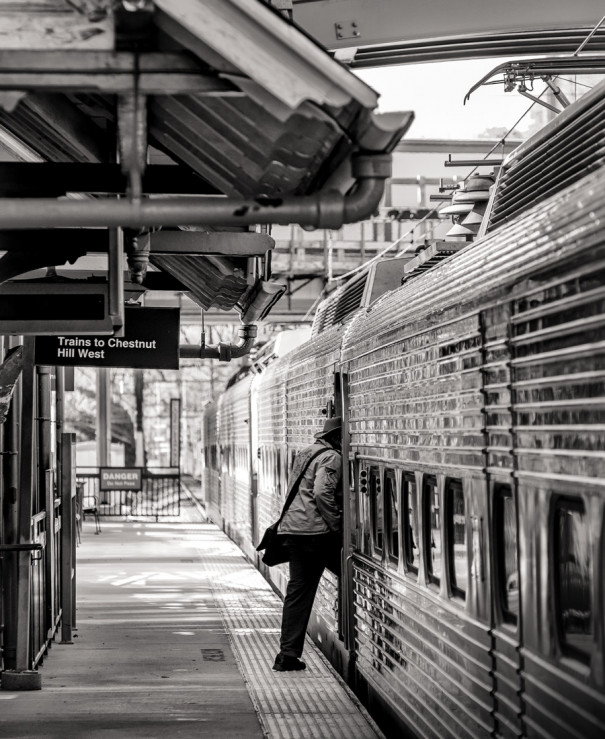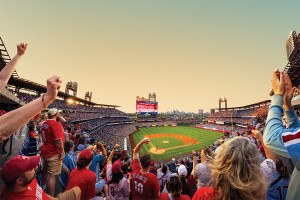What Will Happen to Center City If Commuters Never Return?
Many downtown workers spent the past year working from home. The future of office buildings — and Philadelphia — may depend on what happens next.

One of many Philadelphia commuters boards the Chestnut Hill West Line at Allen Lane. Photograph by Jeff Fusco
As she sits in her West Mount Airy twin, Kisså Reckamp sometimes finds herself missing the commute to Center City.
Admittedly, it only takes a moment to stroll up to her bedroom after breakfast and start working at her job for a small law firm. But commuting downtown brought variety to her life. Mount Airy is relatively dense for an American neighborhood, but it’s still got a folksy suburban vibe; the same people pop up at the park, then again on Germantown Avenue and at the Weavers Way Co-Op. Downtown Philadelphia, by contrast, offers the epic sweep of life in one of the nation’s biggest cities.
Reckamp usually took the train to work, using a $144-a-month SEPTA pass. From Suburban Station, she walked to the Land Title Building on South Broad Street, which is expected to contribute $903,325 to the city’s property taxes this year. From there, she could pop out at lunch for a dental or hair appointment or to do a little shopping. Then there were the food options, which were, to put it mildly, more varied than the restaurants in Reckamp’s neighborhood. She was a part of the massive downtown economy.
Reckamp can count on one hand the number of times she’s been downtown in the year-plus since the COVID-19 pandemic swept America. For her, those days are permanently over. She won’t be going back to Center City; her law firm has moved to Germantown. But she doesn’t even anticipate going back to that office full-time. “When we return,” says Reckamp, “I’m planning to ask for more flexible time.”
Reckamp isn’t alone. Before the pandemic, less than a tenth of the American labor force worked from home; now, more than a fifth are doing so. Yet even that undersells the extent of the change. Two-thirds of the nation’s professional-class workers, the kind who filled the offices of Center City and its counterparts across the country, were working from home at the height of the pandemic. The freelancing platform Upwork estimates that nationally, 20 to 25 percent of those professional jobs will become permanently remote over the next five years.
Remote working was never intended to be permanent — some people find it isolating; younger workers miss out on networking and mentorship — and many large employers have signaled their intent to get workers back in-house. “Frankly, I don’t give much countenance to the argument that we’re going to move hugely to remote work, or that office buildings are largely over,” says Paul Levy, president of the Center City District.
But for some, there’s no going back — and even if we mostly return to the old ways of doing things, the difference could be massive. “I think what we’re seeing is a sea change,” says Adam Ozimek, chief economist with Upwork. “Even if 80 percent of workers go back to the way things were, a double-digit change would reverberate throughout the economy.”
The future of commuting is about more than where Reckamp and the legions of office workers like her spend their days. It is, in essence, about what Center City will be after the pandemic — about what Philadelphia will be. And while some projections are bleak, not all are.
Cities have always been defined by an abundance of work and the technology available to access it. In Philadelphia’s early history, few commutes were longer than a mile. Everyone walked everywhere, but those with money walked least because they could afford to live closest to their concerns.
As late as the mid-19th century, the Philadelphia suburbs of Southwark and Northern Liberties were known in genteel circles as lairs of sinful, poverty-stricken commuters. When Philly annexed these townships, wealthy city interests led the charge, hoping to curb perceived lawlessness in the “dens and shanties of the suburbs,” as one contemporary writer put it.
You’ll have noticed that times changed.
First, streetcars and trains spurred suburbs-in-the-city like Reckamp’s Mount Airy, West Philly, and the towns along the Pennsylvania Railroad’s Main Line. In the 1920s, automobiles began to proliferate, and the modern era of suburbanization began, accelerating as highways like I-76 were built in the post-war era. By 1980, almost 70 percent of the region’s population lived outside cities. Now, the commuter stereotype is that of well-heeled people in the suburbs — the exact inverse of the city’s early history.
Pre-COVID, Matt Pfluger’s 75-minute commute into Center City involved driving to SEPTA’s Langhorne Regional Rail stop, taking the train to Market East, then continuing to his Old City office by subway or on foot. “On beautiful days, everybody would be out on the porch, we’d be laughing, we’d be collaborating, the sun would be shining, and we’re in the middle of Philadelphia,” says Pfluger, who works for an advertising firm. “There’s definitely an energy when you’ve got creative-minded people building off each other in the same environment, in a cool space, in a cool town.”
In the late 20th century, as the manufacturing that had marbled many neighborhoods faded, the jobs that remained were largely in services, like those provided by Pfluger and the people who cleaned his office or made him coffee. A great many of these were in Center City, which gained in relative importance as one of the few remaining redoubts of decently paid employment. Higher-end service jobs like Pfluger’s and those in “eds and meds” became the centerpiece of Philadelphia’s economy and a roundabout means of a little income redistribution. In a part of the country with no regionally shared taxes and few cross-jurisdictional public services, these jobs have been a way to extract some suburban wealth.
In 2019, nearly 120,000 people commuted from the suburbs into jobs in Center City (not including those headed to University City or other job hubs like the Navy Yard). The Center City District calculated that downtown office workers like Reckamp and Pfluger spent a collective $824 million annually on food, retail and other services around their office buildings, which also contributed to Philadelphia’s coffers. Commuters coming from the suburbs added some $875 million in wage taxes to the city’s budget annually. A potential long-term post-pandemic shift from commuting to remote work imperils all that revenue.
“If we’re going to see this shift over time, we’re going to have a less stable wage tax, less sales tax revenue,” says Akira Drake Rodriguez, an assistant professor of city and regional planning at Penn. “This is a shift in how cities are going to look and operate.”
The sorry state of Philadelphia’s budget testifies to the depth of the issue. According to the Pew Charitable Trusts, that budget shrank by 14.7 percent in 2020, and the city’s dependence on the wage tax is a huge part of the problem. The retreat of suburbanites and mass unemployment among lower-income Philadelphians have combined to wreck this revenue stream — even as demands on city services have soared. That budget crunch will presumably ease somewhat as life settles into a new normal, but even marginal changes to remote work and commuting could leave deep scars. In the most calamitous scenario, suburban commuters stay home en masse. Office buildings could be forced to downsize, with corresponding hits to property and wage taxes. Then there’s the question of consumer spending: All those coffee breaks, catered lunches and happy hours add up to a lot of jobs, small businesses and sales tax revenue.
For Kiki Aranita, owner of Poi Dog, a lunch counter serving Hawaiian-style food, the loss of office workers meant the end of her restaurant. To break even, the eatery had to be consistently busy; she’d chosen her location by counting weekday afternoon passersby at several different storefronts. To make a profit, she needed to cater office functions, so she built up a reliable trade with downtown law firms and corporate offices as well as with Penn.
The pandemic eviscerated all that. She closed Poi Dog in July after gaming out her takeout volume and determining there was no foreseeable path to profitability. Even now, as the vaccine rollout quickens, there are too many unknowns. “If you don’t know, how do you open a business?” asks Aranita. “I am not the kind of person to operate on hopes and dreams.” According to a February report from the Center City District, 32 percent of surveyed eateries there were closed as of January, and 7.6 percent said they had no plans to return.
Or consider SEPTA’s regional rail network, which was retooled in the 1980s to prioritize the needs of suburban commuters. Ridership on those lines is down 85 percent from pre-pandemic figures. People like Pfluger have turned to their cars, and it’s unclear if they’ll ever go back.
The fear inspired by a pandemic can long outlast the disease. After the far-smaller SARS outbreak in 2003, transit ridership in hard-hit cities like Taipei remained depressed for six months after the virus retreated. Today, in countries like Taiwan, Singapore and New Zealand that successfully repressed COVID, transit ridership hasn’t returned to 2019 levels.
For now, SEPTA is supported by massive volumes of aid from the federal government, and its inner-city services are seeing more robust demand. But if riders continue to avoid SEPTA or simply never return downtown, that vast commuter rail system — like the food scene in Center City and the wage tax — will need rethinking.
There’s no bigger downtown booster than Paul Levy, and he says that while a lot could go wrong for Philadelphia post-COVID, a lot could go right, too. “I’ve lived through other really big downturns when people had cataclysmic views of the future,” says Levy. “The mood of the moment may not be the mood in six months.”
In March, business, political and labor leaders launched the $1.5 million “Ready. Set. Philly!” campaign to coax employers, commuters and shoppers back to town. The initiative’s director, Angela Val, doesn’t anticipate a full return until autumn. There are a lot of unknowns, but that doesn’t mean doom-laden scenarios are locked in.
“I think a lot of things are going to be restructured, and that’s not a bad thing,” says Val. “There will be discussions about tax policy, about what office space looks like, the structure for SEPTA, how much restaurants rely on takeout. We can adapt.”
Take SEPTA. Right now, commuter rail ridership is apocalyptically low. Perhaps those who return will drive more, which would increase parking demand, accidents and traffic issues in a city that was recently ranked the second most congested in the country by the transportation analytics firm INRIX, Inc. A few months of sitting on a highway-turned-parking-lot and then paying through the nose to stash the car could push nervous riders back onto trains.
Suppose, though, that a substantial chunk of riders don’t come back because of an increase in remote work. That could give SEPTA the opportunity to retool its existing network to better serve “essential” workers who never stopped commuting to jobs at grocery stores, nursing homes and hospitals.
Regional Rail fares are at least twice those of mass transit, and the schedule is extremely sparse except during peak commute hours. Thoughtful changes could attract a different set of commuters who might then also use trains for errands and leisure — especially appealing for those lines that pass through dense urban or inner-ring suburban neighborhoods. Similar overhauls are taking place in Boston and Chicago, and in a post-COVID transit plan, SEPTA policymakers supported reimagining Regional Rail “as a frequent, metro-style service.”
The future of office buildings, should the commuters stop coming, doesn’t have as obvious a remedy. They could theoretically be converted to housing, though it also isn’t clear that in a post-COVID world, fewer workers would translate to less office space. The open office is likely a thing of the past. “We were moving toward an incredibly dense use of office space,” says Levy. “That’s over. We’re tending now toward more square footage per person as a legacy of COVID.”
Then there’s the other lens through which to view this situation. In Philadelphia, decreased commuting won’t just mean that suburban residents come to the city less often. Unlike Boston and New York, where most white-collar jobs have returned to the city since the 1970s, the Philly region still has plenty of those jobs in the suburbs, meaning many Philly residents had been “reverse commuting.” In 2019, the Center City District noted that Philly’s job total is still 23 percent below 1970 levels, while both Boston and New York have more jobs now than they did then.
Caitlin Stanley was one of those commuters, driving an hour by car every day from Grad Hospital to an office park in Horsham for her advertising job. A lot of her friends made similar trips. According to Census data, as of 2018, at least 260,000 Philadelphia residents reverse-commuted from the city to the suburbs; 41 percent of workers who live in the city are employed outside its boundaries. In D.C., the figure is 33.7 percent. In New York City, it’s 15.3 percent.
“There’s a high proportion of people that leave Philadelphia and drive to jobs in Montgomery or even Chester County,” says Stanley. “I’ve always thought that holds our city back.”
For Stanley, the contrast between her pandemic life and the years when she commuted to the suburbs is stark. Before COVID, Stanley got a new job in Center City. For three weeks, she finally got to walk to work from her house. It was perfect. After a year of working from home, she’s realized how much her old routine ground her down. “After this, I would never consider an opportunity that wouldn’t allow me to walk or take public transport to work,” she says. “I wouldn’t leave Philadelphia again unless I was fully remote or only had to commute one day a week.”
There are possibilities in Stanley’s dreams for a city like Philadelphia, which has far cheaper housing than its coastal counterparts but similar urban amenities. A trend away from commuting and toward remote work could actually maximize those advantages and even allow people to move into the city. Meanwhile, jobs in New York or even D.C. become more attainable for a Philadelphian if you only have to go into the office once or twice a week.
“Philly needs to focus on the quality-of-life stuff,” says Upwork’s Adam Ozimek. “People are going to be making location decisions less about living near work. It’s back to the basics for a lot of places.”
Philadelphia policymakers haven’t always excelled at the basics. Decades of racial segregation have undercut Philadelphia’s school district, the state of which has long been cited as a reason for those with resources to move to the suburbs. Gun violence — another manifestation of segregation — may scare off those with a choice, too. Maybe business groups’ warnings about the wage tax will prove correct and keep new employers away. (It’s notable that Boston, which relies on real estate taxes, barely saw any budget decline last year.) The challenges are legion, but there’s also a chance for Philadelphia to have a different relationship with its suburbs and its commuters. The question is whether policymakers have the will to find real solutions.
“There’s an opportunity for the city to focus more on our strategic advantages,” says Levy. “We have a huge advantage to capitalize on in the quality of life and greater affordability. There’s an opportunity to position Philadelphia so that even if we may lose some people, we can gain others.”
Published as “End of the Line?” in the June 2021 issue of Philadelphia magazine.


